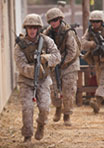 Counterinsurgency (COIN) operations are actions taken by the existing government of a nation to contain and defeat an insurgency seeking to destabilize the government.
Counterinsurgency (COIN) operations are actions taken by the existing government of a nation to contain and defeat an insurgency seeking to destabilize the government.
Current Status: Since the Korean War, a common theme in most American overseas military operations has been some element of Counterinsurgency. It’s no coincidence that this period has been plagued with less than stellar results militarily.
Civilian leaders are not properly experienced in, or don’t care about, the complex military, diplomatic, social, and political interactions that characterize any counterinsurgency effort. Senior military leaders are often not much better. This often leads to the United States committing military forces to ill-advised counterinsurgency campaigns that suffer from:
- Inappropriate use of conventional tactics
- Underuse of Special Forces capabilities
- Incompetently handled public relations
- No clear definition of objectives or victory conditions.
This inevitably leads to a military and political “quagmire,” where our soldiers are committed to increasingly unwinnable conflicts with no apparent strategy to withdraw.
Correction toward the Ideal: The national civilian leadership needs to be educated in the capabilities and proper use of the US military. Further, military leaders should advise the civilian commanders to develop clearly defined, achievable objectives and challenge the advisability of a counterinsurgency combat mission. Mission objectives should be effectively communicated to the US public to create reasonable domestic support of any operation. Further:
- Unconventional warfare specialists must not be faced with a dead-end career path to promotion—which is normally the case today.
- Military academies should study successful counterinsurgency operations throughout history, identify the ingredients for those successes, and advocate doctrinal changes to emulate winning strategies.
- Civilian and military leaders need to be trained to resist the temptation to employ conventional units and tactics when a smaller unconventional footprint is more appropriate.
Because the nature of counterinsurgency entails a rapidly changing political and operational environment, American civilian and military leaders should improve processes and best practices for realistically assessing status, making corrections, and using pre-defined triggers to know when it is time to withdraw American involvement.
Supporting Information: See the Learn More section to the right for more information on this topic—especially our white paper on Counterinsurgency Operations.



